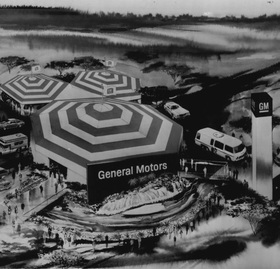|
J. William T. "Bill" Youngs, The Fair and the Falls: Spokane’s Expo ’74: Transforming an American Environment, Chapter Twelve
|
"King Cole, left, president of Expo ‘74 is presented with a plaque recognizing Expo’s contribution to “stability and harmony” in world trade from Wendell Satre, vice president of the trade council, and president of Washington Water Power Co." Courtesy of the Spokesman Review
|
Chapter Twelve: Wooing the Domestic Exhibitors
|
SummaryWhile pursuing exhibitors abroad, the Expo staff also had to work on recruiting domestic exhibits. Corporations were a hard sell -- few businessmen had heard of Spokane, and many were turned off by the fair's theme, which they thought was too controversial. Lining up entertainment proved to be equally difficult, and at first only high school bands and drill teams were scheduled to appear. But when pianist Liberace agreed to perform, other celebrities lined up to be part of the "World's Festival of Entertainment." The Smithsonian agreed to sponsor a "folk life festival" where various traditional arts and crafts and ethnic cultures would be showcased. The Native Americans, who were invited to participate, ended up having the largest presence at the folk life festival.
|
Author reads from the Text
"I mean, it was hard."
"Expo had to overcome several major obstacles in attracting exhibitors. First there was the fact that even in the United States, many people hardly knew where Spokane was. Diane Bingham-Munger, one of the first fair employees, noted that the initial reaction of many companies was 'in Spokane -- are you kidding?!' It was difficult to persuade companies 'that they wanted to come here, to a place that they'd not heard of. I mean, it was hard.'"
"That theme doesn't sell exhibits."
"Paul Creighton, Expo's vice president for operations and maintenance, reckoned that the environmental theme cost the fair many potential exhibitors. In an interview conducted in 1975 he related: 'I'm all for the environment and ecology, but I'll tell you, never put a world's fair together with a controversial theme! The odds are too great that you're not going to make it. Not theme-wise -- everyone thinks the theme is great, but the problem is that theme doesn't sell commercial exhibits because it's controversial.'"
"Situated atop all Indian history"
"Alex Sherwood, the tribal leader of the Spokanes, expressed skepticism about Expo's good will to the Indians. The fair was being held on lands once occupied by the Spokane tribe, he pointed out, but the Indians were hardly involved in its planning....He also noted that 'Spokane city itself is situated atop all Indian history from the past.' He observed that the past century had not improved the environment. The Spokane River, he said, 'used to abound with fish from the sea; Indians used to come to Spokane Falls from far and nearby places to get their winter supply of salmon, but now since Grand Coulee Dam was built, there is no more fish, and the pollution in the river -- I wouldn't even swim there now.'"

